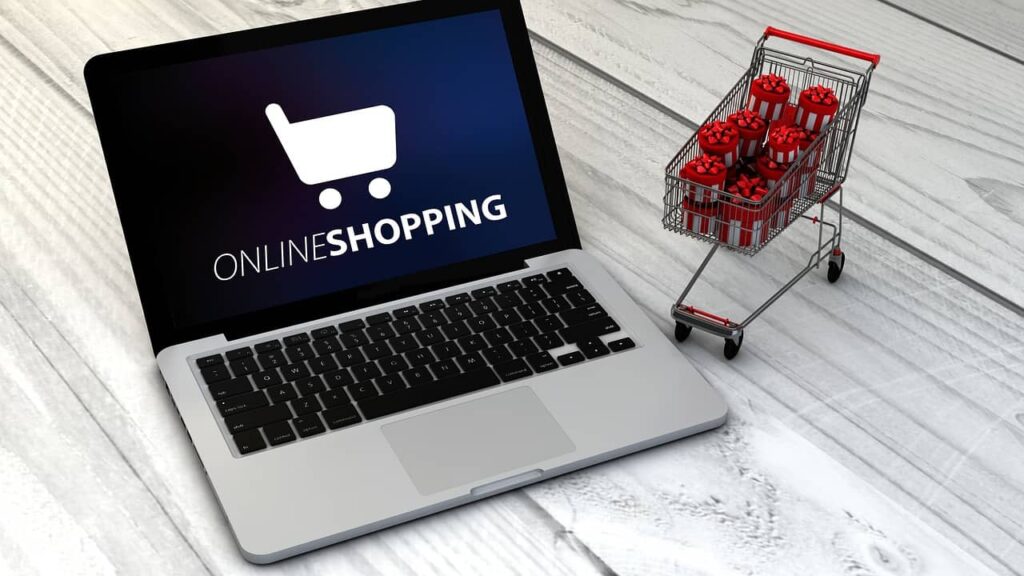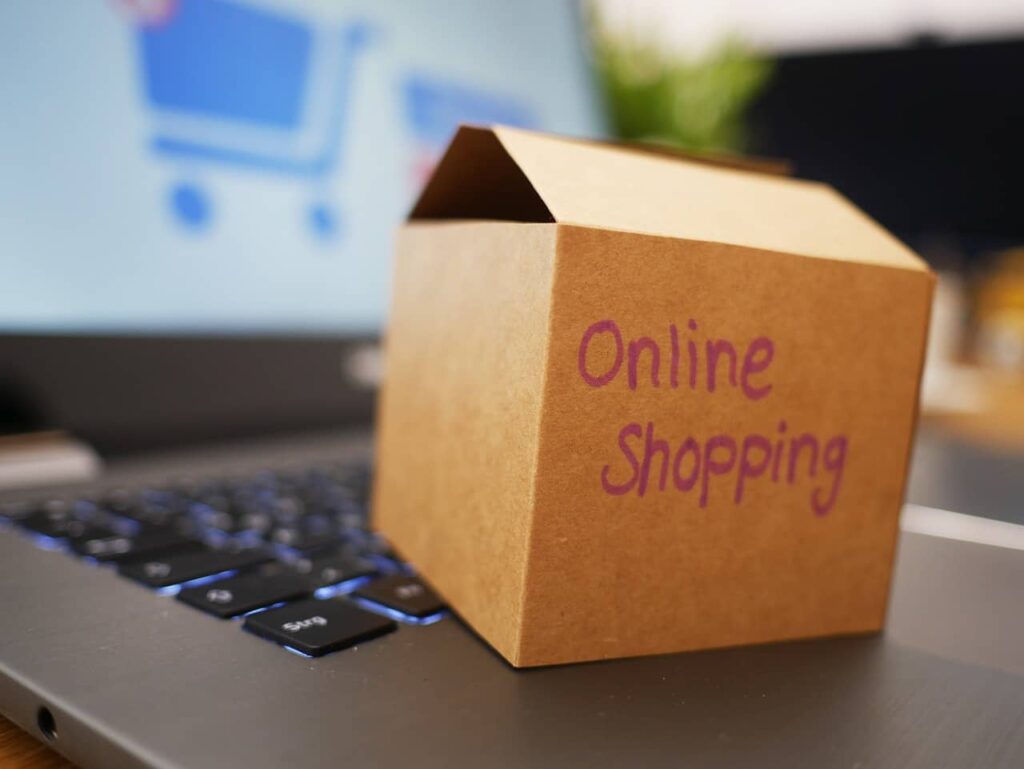A Starter Guide to ecommerce

You plan on moving your brick-and-mortar store to the Internet, but when you think about initiating an ecommerce business, you can’t seem to get enough. The good thing is that it’s not so difficult to set up an ecommerce business and start selling online. With today’s technologies and tools, you can see in a couple of minutes how quickly this will be possible.
Now take a look: Industry analysts project that by 2040, consumers will handle 95% of all online purchases.
One could argue that if you want to build a successful future for your firm, this is the ideal time to move it online.
Yes, we’re aware of that, and perhaps you will still be asking yourself: Is it appropriate to have an Internet store? And if so, how do I start?
No worries, we’re going to show you everything you need to know about ecommerce in this guide.

What is Ecommerce? Definition, type, examples
- What is ecommerce?
- How does ecommerce work?
- Types of ecommerce models
- Examples of ecommerce
- Why is it convenient to do B2C ecommerce?
- Stats that show the importance of online shopping for your business
- How to start an online business in the first place
1. What is Ecommerce?
ecommerce is “electronic shopping”, It’s the purchase and sale of products and services online. It is possible to carry out transactions on a computer, tablet, or mobile device.
While ecommerce is primarily the purchase of physical products on the Internet, there are other ways to make use of this concept, such as digital downloads, online banking, auctions, and other interactions that take place over the Internet.
While ecommerce and business-to-consumer ecommerce (B2C ecommerce) are sometimes used synonymously, they have significantly different definitions. Business-to-consumer e-commerce includes all the activities related to Internet commerce for which a business offers products and services, as well as companies offering them over the Internet.
The use of online systems for email promotion, inventory management, human resources, or other services may be used in B2C ecommerce. Imagine you’re operating a brick-and-mortar business that provides makeup consultation services to customers. You’re only supposed to see clients in person, but you may also make use of an online reservation and appointment reminder system. You’re engaged in B2C ecommerce, regardless of whether you make digital transactions, as long as you use internet tools to manage your company.
On the other hand, online shopping is an exclusively business transaction in which goods or services are exchanged over the Internet. ecommerce may be divided into all parts of a sale, from ordering to packing to delivery; the latter can fall within one of these processes.
2. How does Ecommerce work?
If you ever buy something through the internet, you’re already involved in ecommerce. Likewise, if you’re purchasing a digital subscription or service, Even though transactions appear to be simple and seamless, there are several procedures in place for each order. It’s just one part of the puzzle when it comes to submitting an order. Payments, order management, and the delivery of goods or services require additional measures.
Think about what’s going to happen when you buy something from the shop to get a better understanding of how ecommerce works. Imagine that you’re going to buy a new teapot. You’re going to visit the shop and look at the kitchen goods section. You will go to the payment register when you select your preferred model of teapot. The associate’s going to take your transaction into a bag so that you don’t have to carry it.
The same basic steps are involved in the ecommerce process: browsing for and selecting a product, making a purchase, and receiving packaged products.
In this summary of the steps that take place whenever you purchase something from an online store, a quick overview is given:
- Order submission: You’d like to buy a new lamp from one of your favorite online stores. Your browser will communicate with the server that hosts a vendor’s site while you are on your visit.
- Order management: The Web server sends your order to the company’s online ordering system, which keeps an eye on it through submission and shipment. The order management system will send the query to the company’s stock database to find out if an item you are looking for is available.
- Stock management: The stock database shall forward your order to the merchant system for processing if a lamp you wish is in stock. However, this database can order a new supply if the item is not in stock, and it can be checked to see how soon these items will become available and provide an estimation of their availability.
- Payment processing: Once stock availability is confirmed, the stock database transmits your order to the merchant system, which is run by a credit card processing firm or bank. During this process, the merchant system may communicate with a bank’s computer to confirm that an amount is available for purchase. The merchant system shall authorize your transaction once confirmation of the funding has been made.
- Order confirmation: You will receive an order confirmation message on your company’s Internet site as soon as the purchase has been confirmed by a vendor’s system. This message will give you information about the company’s processing and completion of your order. You will also receive confirmation of your order by email and text message, along with information on the processing or delivery of orders.
- Order packaging: Information about your order will be passed on to the retailer’s storeroom by an order management system. This information is used by the warehouse team to pick up and package your goods, preparing them for shipment.
- Order dispatch: The warehouse ships your order. The seller often relies on a third-party delivery service that will deliver the product to you.
As you can see from the picture below, effective online shopping relies on a variety of technologies that work together in concert to handle any transition between order and delivery. Despite the important role that technology plays in ecommerce, many processes need to be conducted by human beings, such as logistics professionals.
ecommerce may be convenient and easy to do, but complex behind-the-scenes processing is needed to perform all transactions. You don’t need to deal with every step on your own. Retaining a consultant or support professional can help you set up your ecommerce operation or manage critical processes.
3. Types of Ecommerce models
You can find a niche, no matter what the focus of your business is. There’s a possibility for every type of e-commerce model in the four main types:
- Business-to-consumer (B2C): A business transaction involves a company selling products or services directly to consumers, also known as consumer ecommerce. For instance, if you buy a new pair of jeans from the department store, it’s like B2C ecommerce.
- Business-to-business (B2B): All trade between two businesses shall be covered by B2B ecommerce. The sale of products to business customers, like a new printer, can be part of this. Similarly, B2B services such as network monitoring may be sold by companies to organizations.
- Consumer-to-consumer (C2C): The term C2C ecommerce is used to describe the sale of something by one person to another. For instance, you can post an ad on Craigslist or Facebook Marketplace for your car and sell it to a different person at the same time.
- Consumer-to-business (C2B): C2B ecommerce transactions, if a person sells products or services to a business. When social media influencers receive a fee to promote a company to their followers, one type of C2B transaction takes place.
You can see that there are plenty of alternatives if you don’t operate an online business right now. Selling some personal goods on the internet is a great way to start and learn basic skills, so you can grow up from there.
You should keep an eye out for new ways to sell products and services online. Consider whether it is worth promoting yourself through the Internet to businesses, such as when you have a restaurant that receives online orders and serves customers. Is there a way to do bulk orders for teams or cater for an event? The business of selling meals is not altered under this scenario, and the Internet offers opportunities to reach new audiences and generate new revenues.
4. Examples of Ecommerce
A lot of people think of ecommerce as buying products online and shipping them to their homes or businesses, but that’s not the only business model. There are certain situations in which it is possible to exchange products, but others do not. Examples of opportunities for online shopping can be found here:
- Retail: direct sale of products to consumers without an intermediary.
- Wholesale: Sell goods to a person or company in bulk.
- Dropshipping: To sell a product, including the delivery of it to an end customer by any other means.
- Crowdfunding: collecting money to fund the development of a product before it is placed on the market.
- Subscription: the recurring purchase of the product or service until it is canceled.
- Service: A particular skill or skill that is required for a fee or compensation.
The use of ecommerce allows you to exchange both physical and digital products. What difference does that make? A physical product, for example, an item of clothing or kitchen equipment, is a real thing. On the other hand, it’s hard to touch something like a digitally produced product. Digital products include subscriptions to access digital content or video courses you can view through the Internet.
Moreover, shipping is a component of many ecommerce transactions, but there are other methods to use for buying products online, picking them up in-store, or picking them up curbside to deliver them to customers. With buy online, pick-up in-store clients come into the store and go to a customer service center or another approved location where they pick up their purchase. Curbside pickup lets customers stay in their vehicles and have team members deliver products to them. These options may enable customers to make purchases in a short period while cutting down on shipping costs.
5. Why is it convenient to do B2C ecommerce?
Why should you consider a business-to-consumer ecommerce business model? It’s a good move for every firm to have more than one channel on the market, as we learned from the COVID-19 virus. Many companies that only have an in-person presence lost money when they were required to limit their travels because of public health directives.
The pandemic caused a change in our way of living, working, and shopping. In general, many people were turning to the Internet for shopping for goods and necessities as a result of wide stay-at-home orders. The convenience and value of shopping online have become apparent to people, who are starting to explore various options from stores they’ve never considered before.
You can supplement your retail trade with an ecommerce store, as more consumers have become used to buying online.
It’s convenient to do B2C ecommerce for other reasons. Let’s look at several of them:
- It’s very easy to start: A great way to help you get your online store up and running in minutes is to look for several platforms that can do this. For example, you’re capable of creating a presence on an online marketplace such as Amazon or Etsy. To promote and strengthen your business, you may use tools that can be used for marketing automation, social media scheduling, or SEO optimization.
- You’ll be able to sell a unique skill or product on the market: There are specific talents or passions in many people who have started businesses that they want to share with others. When you start an online business, it allows you to do what you like and make a schedule that works for you.
- There’s a way to generate passive income: Beyond the initial setup, there are several types of income that you can make without very much effort and many passive income opportunities available online. For example, you may be able to examine affiliate markets, display advertising, eBook or course options, and digital product sales. In a business such as yours, those options could keep money flowing normally with a little extra work on your part.
- You’ll be able to work from anywhere: A physical presence at your place of business will frequently be necessary if you have only a brick-and-mortar site, particularly where the company’s turnover is very low. You can work wherever you want with a business on the Internet. It means you can move into another town or state while keeping your business and income in place. You’re also capable of traveling and operating your business. In addition, this flexibility makes it easier for you to meet personal goals and resolve family issues in a way that does not disrupt your business.
- High growth potential: ecommerce has been on the rise ever since COVID-19 began to drive customers online. Industry Watchmen forecast that, by 2023, 91% of America’s population will have purchased their goods over the Internet. Think about how much of the world’s population this percentage is! Furthermore, the estimated US market for online retail is over $2 trillion.
Although brick-and-mortar retailing is still very strong, there are indications that B2C ecommerce will soon become the main mode of shopping and sales.
6. Stats that show the importance of online shopping for your business
You may be wondering if it is appropriate for your company, given all the steps that need to be taken before you can start an online business. It is true that in the last few years, ecommerce has been growing at an increasing rate, and it is expected to maintain a high growth trajectory over the coming years.
For your business to be successful, you must remain up-to-date with the most recent trends and projections. For all companies interested in exploring the sale of their products through Internet sales, these statistics provide a convincing case:
- In terms of retail sales, online shopping accounts for more than 14% around the world and is expected to reach 22% by the end of 2023.
- Approximately 95% of all transactions will be carried out through electronic commerce in 2040.
- According to estimates, over $4 trillion of online retail sales are expected in 2020.
- Mobile commerce is expected to make up 72.9% of the total ecommerce market by 2021.
- The number of people shopping on the Internet is over 2 billion worldwide.
- Using a mobile phone, over half of all users complete purchases.
- When it comes to deciding on an Internet retailer, free shipping is the top consideration for consumers.
- Currently, China has the largest online retail market, with sales of over US$1.7 trillion in 2019
- About 80% of US internet users have made a minimum of one online purchase.
- The top reason people choose to make purchases online is that they can buy products anywhere at any time.
It’s obvious that ecommerce is an integral part of our lives and will be one of the most dominant modes of purchasing for decades to come. The time is right for you to start your own business through the Internet to take advantage of the growing opportunities in the ecommerce market.
7. How to start an online business in the first place
It’s hard to start an online business, but having an online store can bring you a lot of benefits in the future and in the years to come. You may find it difficult to absorb the new concepts and technologies you need to learn when considering them. Don’t let these concerns stop you, though.
It’s good news, you can learn proven procedures for starting an ecommerce company by simply following them step by step. The main tasks are similar to what is necessary for setting up any kind of Internet business. It may take a mindset change to establish an online shop, but it is possible to repeat these steps as soon as you understand them and be able to increase the presence of your website or start new Internet businesses.
Step 1. Choose your offerings
Identifying the types of products or services that you would like to sell is the first step in setting up an online business. In certain cases, you might focus on moving your existing offers online if you already have special skills or products for sale in a brick-and-mortar store. However, you can also seek to sell high-value products with strong sales potential.
Where can you get the idea for a product? Current websites such as marketplaces, industry trends publications, and consumer and lifestyle data can be reviewed. If you want to know if you can replicate their success, check out what leaders sell in the ecommerce niches. To keep up to date with the latest news in your area, check out product and trend discovery websites for daily information on top-selling products.
You need to know how you’re going to get them when you figure out what kinds of products you want to be selling. You’ll do it yourself, won’t you? Is there a need for potential suppliers or wholesalers to be found? To establish a suitable combination of product quality and value, you must explore all possible options.
Step 2: Search for your target audience and competitors
It is important to understand the audience for your product once you know what kind of sale you’re trying to make. You should consider their demographics, budget, and pain points so that your product can meet their needs.
Find out how your competitors are doing, too. What’s the other place selling similar products? How do you determine their assets and vulnerabilities? You’ve got to know who they are, understand what they’re saying, and figure out how you’re going to differentiate your business and stand out.
Step 3: Write a business plan
One of the most important steps before opening an online store. You’ll define your objectives and targets in the business plan, as well as specific steps that you will take to achieve them. You will clarify your finances, as well as confirm the marketing strategy. You shall also define the core management, logistics, and operating plans.
Why is it so important to have a business plan? A clear vision of the direction you want to take is provided in your business plan. Moreover, a good business plan will help the banks and investors recognize your enterprise as an appropriate investment if you are looking for funding.
Step 4: Find a business name
Another important step in establishing an ecommerce company is the choice of a business name. The first step is to figure out the possible names and then compile a list of those you’re interested in. But you must not simply choose your favorite; you must go through with it. Check with the local Small Business Administration (SBA) to be sure the name hasn’t been registered, and begin the steps to register yours.
To explore ideas and find available domains, after you have a list of potential names for the business, access domain research tools. To work as an online store, you need to have digital assets, which include a website and social media presence. Further, to find out if you can secure suitable addresses that match your domain, perform a search on different social media sites.
A domain name has to be purchased if your Internet business requires a website. It’s an incredibly simple process that will take you only a few minutes. Search for and select a domain name and pay a small fee at an online domain name registrar, such as Google Domains or GoDaddy. Although you’ll have to renew the web address each year, it costs nothing.
Step 5. Create a logo and establish your brand identity
To create an individual and memorable brand identity, your logo, visual identity as well and message must have a distinctive character. In addition to the fact that you may design your logo, hiring an experienced designer can give this essential component of your identity a touch of creativity and professionalism. To give your brand a visual edge, designers can also assist in the selection of color shades, photographs, and pictograms.
A message that expresses the purpose of your firm and tells people why they should shop with you is also going to have to be created. While your memorable tagline may be effective, it’s important to put focused messages into the content so you have a unique business story on display. With this critical assignment, you can be assisted by a brand strategist.
Step 6. Create an online store
Developing your online store will be the next step, first, you have to select a platform that’s best suited to your needs and business model. The most popular ecommerce platforms are Shopify and Woocommerce (WordPress), but you should do your research and look for the best solution for you. If your needs are different, you may want to approach an expert for a recommendation on the appropriate platform.
You have three options once you’ve decided which platform to use:
- Take the DIY route and create your website on platforms such as Shopify
- Contact Khim Agency
- Hire a professional Freelancer on Upwork
Step 7. Build your online presence
You’ll be able to build your online presence when you understand the basics of search engine optimization. You’re going to need a certain skill set in copywriting, design, and photography when you create an online store. It is important to create compelling product descriptions and use photographs and videos to make your products come alive, no matter what type of product or service you choose.
Step 8. Optimize SEO for your online store
Organic traffic to your website or shop is a vital element for the growth of revenue as an internet business. To make sure that you attract the right audience to your web store, you need to learn some basic search engine optimization principles. To help search engines gain better insight into what pages are all about, each page of an online store should be targeted in terms of SEO based on the titles, headings, images, and some other specific HTML tags that you can set inside your code.
CONTACT KHIM AGENCY FOR YOUR SHOPIFY SEO
If you’d like to learn the fundamentals of Search Engine Optimization yourself or delegate these responsibilities to an expert search engine optimization consultant, please do so. Your business will gain visibility in Google and other search engines, as well as attract new customers with the right SEO structure.
Step 9. Determine your distribution channels
Many online shops are gaining customers using established distribution channels, in which the customer already purchases. Amazon’s status as a top marketplace for online retail sales is undeniable, but retailers such as Walmart and Target are also allowing merchants to sell on their sites. eBay is also making it easier for sellers to create shops and Etsy has a strong brand appeal with artisans, crafts, or creatives.
You will want to establish a presence on relevant marketplaces and platforms, as thousands of buyers flock to these sites each day. Before expanding your reach, it is usually best to focus on the first one that you can start with and build a solid reputation.
Step 10. Market your business
Marketing is critical to the continued success of a business as soon as it becomes operational. Luckily, to attract new customers, online businesses can employ several proven approaches to marketing on the Internet. Here are some of the most effective marketing tactics for ecommerce that you need to take into consideration in your marketing strategy, together with a few metrics that prove their worth:
- SEO: To be found by search engines, all pages on your website must be optimized. Effective Search Engine Optimization requires specific attention to the Page elements, such as meta titles and descriptions, in addition to effective copywriting.
- Content marketing: A lot of ways can be explored for the creation of content to help people understand why they are buying from you. Examples of the types of content used by ecommerce businesses are blog posts, ebooks, guides, podcasts, interactive articles, and videos. More than two-thirds of the participants in a research study called for content marketing to become an important strategy concerning digital stores.
- Pay-per-click (PPC) advertising: You can execute PPC campaigns on Google and ecommerce marketplaces. The easy measurement and scale of PPC ads means that, when you acquire campaign performance data, you’ll be able to change the way you approach them. And in terms of attracting people to your site or store, they can be very effective. In one study, 88% of respondents said they had seen an increase in the number of visitors to their websites as a result of PPC advertising.
- Email marketing: For digital businesses, email marketing is one of the cheapest and easiest ways to advertise. What’s the effectiveness of email marketing? A study has shown that email marketing may bring in up to 24% of revenues for businesses, although it accounts for less than 20% of their advertising expenditure.
- Social media: Social networking can help your business make money in addition to being a means of staying in touch with customers. It was believed that 40% of shops made money using social media, with 1 in 4 businesses listing products on Facebook. Additionally, studies have demonstrated that businesses that maintain at least one active social media account outperform those that do not in terms of sales.
Further, you can enhance your ability to draw and convert customers by taking advantage of the rest of the major trends that exist within the digital marketing world.
- Mobile optimization: Industry analysts project that half of all e-commerce transactions will take place on mobile devices by 2020. the entire mobile purchasing journey and optimize for mobile using responsive design concepts. Make sure the images fit on small screens and load quickly. You may also want to think about making the buttons more noticeable so that users can navigate more easily.
- User-generated content: Consumers appreciate the fact that they can find information about products from real people who have experience with the products they are considering online. It is possible to encourage customers to submit user-generated content, such as reviews or photographs of products in use.
- Live chat: Allowing visitors to participate in live chat can potentially improve their purchasing experience. Many digital consumers may find the abundance of options on the Internet to be disconcerting, making them unsure of whether to make a purchase. They might enquire about discounts, return policies, and delivery. Using live chat, you may provide customers the opportunity to ask questions and receive responses from customer service representatives who might be able to assist you with your purchasing selections.
A mix of approaches to attracting visitors as well as motivation for them to become customers should be part of your ecommerce marketing strategy. Market continuously to build a strong pipeline and generate a steady flow of new business.
Although you may be able to handle some marketing tasks on your own, it is a fantastic idea to seek the professional advice of a digital marketing consultant. An experienced strategist can assist you in selecting marketing tactics to attain your sales and revenue goals, as well as perform functional tasks daily that maintain the engine’s performance at its highest level.

Conclusion
No matter what your background is as an entrepreneur or corporate executive, you might need to pick up some new skills to manage a profitable e-commerce business. Firstly, you will have to understand the core steps of each online store and how technology works in harmony with people so that they can help make your e-shop successful.
There are a couple of ecommerce models available to choose from, and you can pick the one that best suits your business. The current business models work very well, either B2C or B2B. But to learn the basics and grow from this point forward, you can always start with a consumer-to-consumer approach.
The fact that you can carry out your business even if you do not have a physical location provides one of the advantages of e-commerce. During the COVID-19 pandemic, it has become clear that having a functioning ecommerce system is beneficial. Nevertheless, you can make purchases outside of business hours with a presence on the Internet. This implies that you can provide your consumers with 24-hour purchasing options even if you’re closed in the evenings or on specific days of the week.
In recent decades, the online retail sector has seen steady growth and will continue to lead purchasing and selling over the coming decades. If you’re just now beginning to establish an online business, you can have an advantage over your competitors. With sound tactics and diligent labor, you can attain both financial success and high potential for an ecommerce firm. If you require professional guidance, there are advisors who can assist you with any stage of the product and audience analysis, business development, logo creation, or marketing process.


3 Comments
How To Sell Online: 12 Steps To Get Started - Khim Agency
November 6, 2023[…] for an ecommerce business […]
What is dropshipping? Everything you need to know - Khim Agency
November 15, 2023[…] small initial investment can be made in an ecommerce business via dropshipping. You may start selling things right away and don’t need to invest […]
Elizabeth Girten
March 15, 2024I will right away seize your rss feed as I can’t to find your email subscription hyperlink or e-newsletter service.
Do you’ve any? Kindly let me know in order that I may just subscribe.
Thanks.